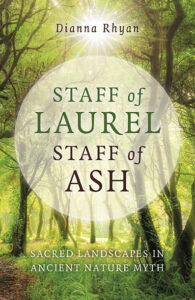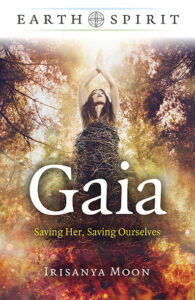Staff of Laurel, Staff of Ash – Sacred Landscapes in Ancient Nature Myth
Dianna Rhyan
Moon Books, 2023. 178 p. ISBN 978-1-80341-196-5 (paperback, £13.99 / $17.95); ISBN 978-1-80341-197-2 (e-book, £6.99 / $8.99)
Gaia – Saving Her, Saving Ourselves
Irisanya Moon
Earth Spirit series, Moon Books, 2023. 96 p. ISBN 978-1-80341-108-8 (paperback, £9.99 / $12.95); ISBN 978-1-80341-109-5 (e-book, £4.99 / $6.99)
“Can myth stop someone from felling ancient oaks?” This is the question Dianna Rhyan asks in the first pages of Staff of Laurel, Staff of Ash. Wandering through nature, she lets her imagination roam through a world of Greek and Near-Eastern mythologies, reflecting on mankind’s relationship to nature.
In a poetic, evocative style she tells of trees, rivers, mountains, goddesses and heroes of tragedy that were destroyed, forgotten, silenced, or suffered a katastrophē (“steep and sudden downfall”). It is a lamentation for a lost world, where everything in nature was ensouled. At the same time, the reader is reminded that Persephone will always come back from the realm of the dead: that what seems lost forever may yet come back one day. But before that happens, there must be grief and anger at where centuries of devastation and deforestation have led us.
Dianna Rhyan discerns two currents in the relation of humans to nature: one symbolised by the ‘staff of laurel’: the blossoming branch of Apollo’s tree the Muses gave to the poet Hesiod, to bring tales of the gods to mankind; the other by the lifeless ‘staff of ash’: the death-bringing spear of Homeric warriors who strove for undying fame.
This dichotomy may be portrayed a bit too sharply at times, as a good-versus-evil dualism, but it does have its use. It points out that to view nature solely as a repository of resources to be dominated and exploited, is ultimately destructive. It emphasises that a different approach is not only imaginable but may be essential to our survival.
In Gaia – Saving Her, Saving Ourselves, Irisanya Moon also calls on myth to think about necessary changes in mankind’s relation to nature. She focuses on Gaia, who is both the goddess of myths and this Earth and its ecosystem, humans included: “We are Gaia and Gaia is us”.
The myth of Persephone is referred to in this book as well, but this author highlights the role of Gaia, who brought forth the splendid narcissus that the maiden goddess desired to pick. When the girl reached for it, the earth opened, and Hades came out and seized her. All of this was according to the will of Zeus. Irisanya Moon writes that wise Gaia must have understood Zeus’ plan and what was going to happen, and willingly assisted. For when Persephone finally brings life back to the dying lands, Earth/Gaia is covered in festive glory.
Whereas Staff of Laurel, Staff of Ash travels back through time and myth in a quest to the roots of the environmental crisis in modern society’s perception of nature, groping and searching to define and find ways to overcome the violence, the abuse and all that went wrong in this disturbed relationship, Gaia is looking forward, concerned with what concrete actions modern pagans can take to support and celebrate Earth, with myth (and facts) providing motivation and a framework to relate to. The difference between both books reflects the different professions of their authors: Dianna Rhyan works as a mythologist and therapist with a focus on goddesses and sacred landscapes, and Irisanya Moon is a priestess and teacher in the Reclaiming tradition.
So if you’re interested in changing the dominant perception of nature as a storehouse of not-yet-dead matter by exploring ancient myths, to be able to experience the natural world as full of nymphs and other goddesses, a world in which wind blowing in leaves isn’t just wind blowing in leaves, but can be an oracle – the rustling in the oak trees of the temple at Dodona, or the scattered leaves with oracular texts of the Cumaean sybil – Staff of Laurel, Staff of Ash provides you with stories, images and ideas that make you feel ancient attitudes are still to be found in the present, somewhere, somehow. It offers the hope that perhaps humanity can find healing for ourselves and the planet if we manage to retrace our steps on the path of violence and exploitation and establish a friendlier attitude toward our environment.
If you are interested in hands-on tips along the lines of: you can seek out environmental organisations or groups to support; celebrate Earth Day; form a group dedicated to cleaning up areas like parks or beaches… or if you want to design a ritual for Gaia but don’t know how; feel you could use a ritual to cleanse yourself of the paralysing feeling that all your actions and rituals are futile; or are considering building a Samhain altar for murdered environmental activists – Gaia – Saving Her, Saving Ourselves offers advice on all this and more.
Obviously, you don’t have to choose between these two! One could say they complement each other. And with all their differences, both books provide food for thought and action, to work on both the inner and the outer world. For those who, while or after reading the books, want to explore and study for themselves the source material used by the writers, there are notes and bibliographies.
Sadly, the bibliography in Staff of Laurel, Staff of Ash is not easy to use. It is alphabetically ordered, mostly by title, but some books are ordered by author. This means that if, for instance, you want to know what exactly is referred to by “Theogony”, you must already know that if there isn’t something with this title mentioned under T in the bibliography, it must be sought under H (its author is Hesiod). But it is a pleasantly extensive bibliography, and useful book data such as year of publication, publisher, and names of translators or editors are mentioned.
Gaia – Saving Her, Saving Ourselves has some endnotes, a short list of resources (books and websites), and a short bibliography. Of the books in the resources list and in the biography, only the author’s name and book title are given, not the publisher and year of publishing. In the bibliography, a little printer’s devil must have had some fun: Green Religion as a book title looks plausible there, but it’s by Walter Burkert and should of course be Greek Religion.


